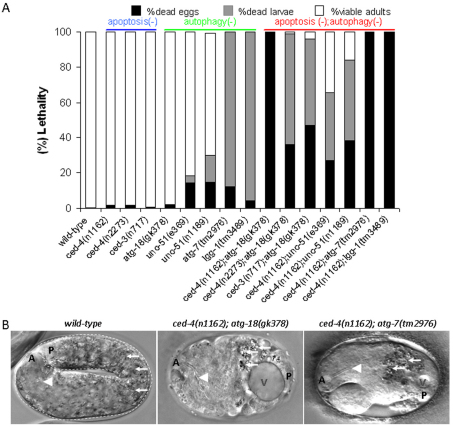Fig. 4.
The apoptotic and autophagic processes are redundantly required for embryonic viability in C. elegans. (A) Viability of mutant animals defective in apoptosis (ced-4 and ced-3 single mutants), autophagy (unc-51, atg-7, atg-18 and lgg-1 single mutants) and both processes (the corresponding double mutant animals). The progeny of ced-4−/−; atg-18−/− double mutants generated by ced-4−/−; atg-18+/− mutant hermaphrodites were scored for the ability to develop into fertile adults. n1162 is a loss-of-function mutation, n2273 is a reduction-of-function (hypomorphic) mutation of ced-4. All of the ced-4(n1162); atg-18(gk378) double mutant animals die as embryos. A portion of ced-4(n2273); atg-18(gk378) and ced-3(n717); atg-18(gk378) double mutant embryos are able to hatch, but these animals arrest development at the early larval stages. Whereas atg-7(tm2976) mutants die as early larvae, all of them die as embryos in ced-4(n1162) mutant background. A similar extent of lethality was observed in lgg-1(tm3489) single mutant vs lgg-1(tm3489); ced-4(n1162) double mutant animals. For each genotype, approximately 300 embryos were assayed. (B) Nematodes defective for both the apoptotic and autophagic processes display severe morphological defects. The left panel shows an elongated, curved wild-type embryo. The middle and right panels show an arrested ced-4(n1162); atg-18(gk378) and ced-4(n1162); atg-7(tm2976) double mutant embryo, respectively. Double mutants exhibit severe body malformations and failure in body elongation. Arrowheads indicate the pharynx, arrows indicate gut fluorescent granules. A, anterior; P, posterior; V, vacuole.

